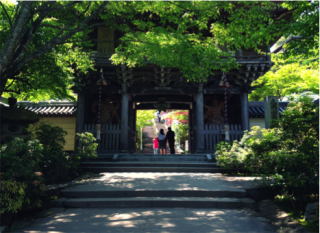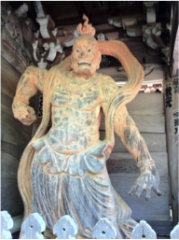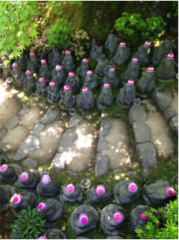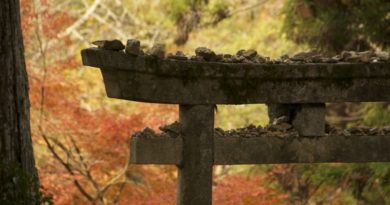Serene Daisho-in
The walk towards Daisho-in temple from the ferry port is relatively short and very enjoyable. When I was there in Spring, the Deer of Miyajima wandered freely around the shops, while the crowds of people walking through the streets parted ways for a newly married couple. The smell of fried foods filled my nose and the laughter of children playing games made me smile.
Daisho-in is the most important temple of Shingon Buddhism. It was here that the sector’s founder first started to preach Buddhism. On the beautiful island of Miyajima, this temple has its own charm. In the year 806, the Monk Kukai, founded the Temple making the temple a little older than 1,200 years.
The large Gate of the Daisho-in temple is accompanied by two large figures called Nio guardians. They ward off evil from entering the temple by standing tall and are very intimidating. I offered a coin, rung the large bell and muttered a short prayer in front of them, and carried on. Beyond the gate are stairs, which lead to the majestic building of the Daisho-in temple. Dividing the stairs are the 600 tiny wheels of scriptures. Running my hand over them as I walked up the stairs, I hoped for the blessing they gave to be true.
There is no entrance fee required, however, there is a donation box in front of the gate. The gates are open from 8:00 am in the morning to 5:00 pm in the evening. Surrounding the temple are small statues of different Buddhist figures, called Jizo statues, many of which include guardians of children with little pink or red knitted hats on their heads. The whole temple was like a small adventure with something new hidden in places you would least expect.
The Kannon-do Hall is the main building that houses the temple’s Kannon statue. The hall is separated into different parts, each dedicated to different things. One is styled in a Tibetan Buddhist fashion dedicated to the 14th Dalai Lama for when he visited the temple. Another section is dedicated to the Emperor Meiji. The area where the Emperor slept is decorated by paintings of herds of soldiers on the stairs of the temple. (note*-unfortunately, pictures are allowed to be taken anywhere except in this area) Incenses sticks are offered and candles are lit at the entrance to the temple. The smell of the incense and the ringing sound of bells follow you throughout the temple.
There is also an underground spiritual path displaying slabs of stones with deities carved in them. The path has no light except for what illuminates the slabs. The light compliments the stones by making it look like it’s glowing in the darkness. The path was so dark that I needed to run my hand against one wall just to make sure I would not bump into someone. The comfortable silence throughout the path helped me think. The underground path can be accessed by a stair well on the left side of the entrance. There are small arrows guiding you there, and at first it may seem like it is somewhere you might not be allowed to enter, but it is in fact the correct entrance to the path.
As I walked up as second stairwell, the Daisho-in 500 Rakan statues, with different funny poses, accompanied me to the Henjokutsu Cave. A collection of Buddhist icons awaited me there. The lanterns hanging from the ceiling give off an eerie glow and cast just enough light to see the statues. I walked towards the cave and suddenly a hymn flowed into my ears and left once I walked out of the cave entrance. The cave gave me an immense sense of serenity.
The one thousand Fudo Images or Immovable Kings followed the path of the cave. The statues stand firm and look like they have golden dust on them. The sheer number and the powerful aura the statues gave off was incredibly humbling. The seven Jizo Bosatsu images line up facing the other structures and are believed to redeem the spirits of deceased babies and children. As I watched people pour water on the statues to console their loved ones I felt an outpouring of bittersweet emotion.
Daisho-in has an amazing view of the island and was very peaceful. According to the locals, the best time of year to visit the temple is in autumn when the maple leaves change color and fall. As I left the temple, still in awe from what I had seen, a light breeze came through and rustled the leaves in the branches of the trees. The atmosphere of the temple was very tranquil and the temple is definitely worth going to if you are ever visiting Miyajima. The experience I had here at the temple and in Miyajima was amazing, and one I will never forget.
For more information on Diasho-in check out Miyajima’s official tourist page on Daisho-in.
Photos and Writing by Galek Yangzom, Student, quite unextraordinarily ordinary, has a slight obsession with whales and loves to read.
















